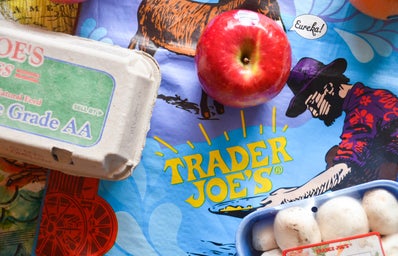As a college student, the importance of finding affordable groceries cannot be overstated. That is why many shoppers, like myself, gravitate towards the low prices that can be found at Trader Joe’s. This, on top of the brand’s delicious yet unconventional food products, set it apart from other United States grocery stores. Their affordability is certainly a selling point, and it’s established an almost cult-like following from its loyal shoppers, but how is it that Trader Joe’s can maintain their low prices?
Much of it has to do with the products that Trader Joe’s chooses to sell. Anyone who has visited the store would immediately notice that there are no name brands. Mostly all of the products carried are in-house. By selling private labels, it allows the store to buy products directly from grocers, which eliminates the lengthy supply chain that most stores generally have to go through. This process cuts down on consumer costs and allows Trader Joe’s to sell items under their branding. This also grants them the freedom to explore more unique yet risky products. Popular items like the Philly Cheesesteak Bao Buns or the Chocolate Lava Cake Gnocchi may appear strange to first-time shoppers. Still, novelty combinations like these are what make customers return.
Although the company is known for its specialized products, it does not have a factory to create them. Rather, everything is negotiated between Trader Joe’s and select grocers, many of which are name-brand giants. It is difficult to find more information on this, seeing as there are strict, non-disclosure acts that limit us from knowing the exact details of these negotiations. However, there are details such as ingredient lists or manufacturing recalls which provide the public with clues as to what brands Trader Joe’s is selling. For example, many have speculated that the store’s mango smoothie has the same ingredient list as the Naked Mighty Mango Juice, just with a new repackaging.
On top of this, Trader Joe’s approaches marketing differently than most grocery store giants today. For the most part, Trader Joe’s does not depend on any advertising. Instead, they receive most of their popularity by word of mouth. Rather than promotion through commercials or billboards, Trader Joe’s has earned most of its success through the relationship it builds with shoppers. Whenever a new product is released, it is most likely “advertised” by fulfilled customers. While Trader Joe’s does have a large social media presence, most of the people posting about the store are completely unaffiliated with the company. There are currently thousands of Trader Joe’s food review accounts on Instagram, Facebook, and Tiktok. Together, these creators have amassed millions of followers.
With its Hawaiian shirt uniform and crazy food combos, Trader Joe’s has succeeded in becoming a competitor among other big corporations. Since its first location opened in 1967, Trader Joe’s has flourished through its unique business model and food philosophy — a system that prioritizes high-quality foods without the need for recognizable name brands. Whether or not you are a fan of Trader Joe’s, it has offered shoppers a fresh perspective on the tedious chore of grocery shopping.
Want to see more HCFSU? Be sure to like us on Facebook and follow us on Instagram, Twitter, TikTok, YouTube and Pinterest!


